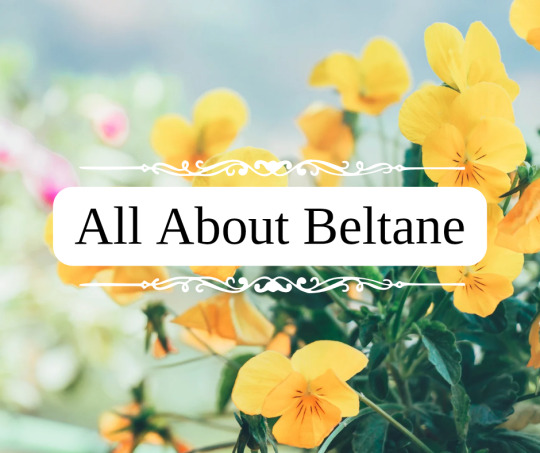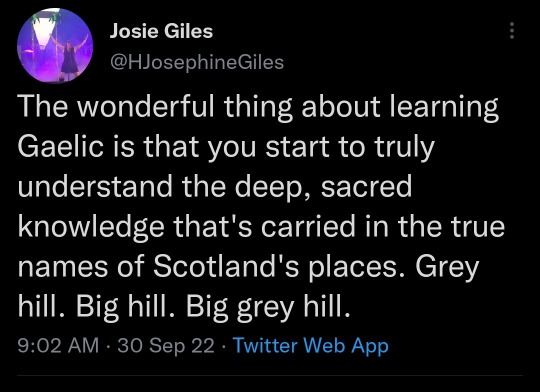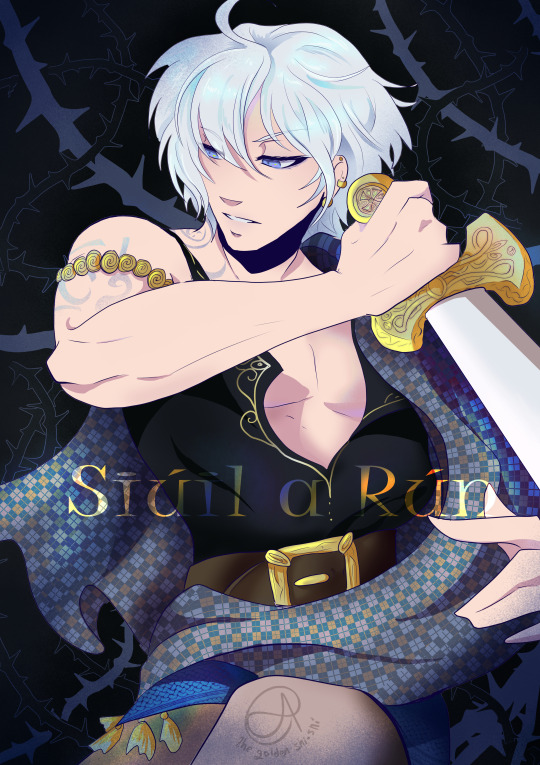#gaelic
Text

All About Beltane
Beltane, also known as Bealtaine in Irish, is a Gaelic holiday traditionally held on May 1st or the halfway point between the spring equinox and the summer solstice. It is believed to be named after the Celtic sun god Belenus. It was widely observed in Ireland, Scotland, and the Isle Of Man, and is one of the 4 major Celtic fire festivals. It is mentioned in even the earliest Irish literature and marked the beginning of summer and used as the marker to drive cattle into their summer pastures. Although public celebrations have mostly fallen out after the 20th century and many traditions have been mixed with other cultural holidays (such as the Roman holiday May Day), many Celtic Neopagans and Wiccans still celebrate, and many local traditions still continue, causing it to now get a cultural revival.
Traditionally, rituals were held to protect the livestock that moved pastures, along with crops, dairy products, and people, and to encourage growth. It was also important to appease the Aos Sí, or nature spirits/fairies, which were believed to be more active then.
According to early medieval texts in 908, druids would make two bonfires and drive cattle between them to protect them from disease. In the 18th and 19th centuries, bonfires continued to be an important part of the celebrations. Before the bonfires were lit, all hearth fires were put out, and then relit using the fire from the Beltane bonfires after the celebration.
Continuing into the 19th century, cattle were still driven over or between flames, or sometimes around the fires or made to leap over. The people themselves did as well for good luck and protection. Once the fires died down, people would dab themselves with the ashes and sprinkle them over their crops and livestock. Torches from the bonfires would also be brought home and carried around the home or boundaries, and also used to relight the hearth.
Food was also an important part of the Beltane festival, and usually included a feast of lamb, which, historically, was sacrificed. In 1769, it was written that a hot drink, called a caudle, made of eggs, butter, oatmeal, and milk was served, along with tossing a bit on the ground as an offering. A Beltane Bannock, a type of oatmeal cake, was also written to be important and had a few traditions around it.
In one tradition, the Beltane Bannock had nine knobs on it and each person would take the bannock and face the fire, proceeding to break off the knobs of bannock one at a time and tossing them behind their shoulder as an offering to the spirits for protection over their livestock and from predators (one for the cow, one for the sheep, one for the fox, etc). Afterwards, they would drink the caudle.
According to other 18th century writers, there was another Beltane Bannock tradition where the bannock would be cut into slices and one was marked with charcoal. The slices were then thrown into a bonnet and everyone would take one out while blindfolded. According to one writer, whoever pulled the marked bannock slice had to leap through the fire 3 times. According to another, the person would instead be pretend-thrown into the fire and for some time afterward people would talk about the person as if they were dead. This may have always been symbolic, or it may have been a tradition from a time where actual human sacrifice was used. This tradition was also near identical to May Day traditions that occurred in Wales and other parts of Europe, however.
Other traditions including flowers and plants were also observed, especially ones that evoked fire. Documents from the 19th century cite that yellow and white flowers, such as primrose, rowan, hawthorn, gorse, hazel, and marsh marigold was used and placed at doorways and windows. Sometimes they were strewn into garland, and other times they were made into bouquets, made into crosses, or fastened to them. They were also fastened to cows and milking/butter equipment.
Decorating a May Bush or May Bough was also a widespread tradition, and it usually consisted of a small tree or branch (typically hawthorn, rowan, holly, or sycamore) decorated with bright flowers, ribbons, candles, painted shells or egg shells from Easter, and more. In some traditions they also decorated it with gold and silver May Balls, which were hurling balls, that were then either given out to children or gifted to winners of a hurling match. It was also known as the only acceptable time to cut a thorn tree, as they were associated with fairies and may have also been a relic of worshipping tree spirits. It would either be decorated where it grew, or branches hung over windows, doors, roofs, and barns either inside or outside. Traditionally, it was the responsibility of the eldest of the house to decorate it.
The tree was usually left up until May 31st, but in some traditions it would be burned in the festival bonfire after singing and dancing around it. In Dublin and Belfast, May Bushes were brought into town and decorated by the whole neighborhood, with each neighborhood competing for the most beautiful bush. These competitions could also lead to neighborhoods attempting to steal others May Bushes, which eventually led to the May Bush being outlawed in Victorian times.
Appeasing the fairies was also a big part in Beltane celebrations, with many traditions revolving around offerings to the fairies and also warding them off, as there were many fears around them stealing dairy. One protection tradition was to leave 3 black coals under the butter churn. Another was to hang May Boughs on the milk pails. And yet another was to hang cattle tails in the barns. Flowers were also used to decorate the cattle's horns for good luck.
Farmers would also lead a procession around the boundaries of the farm and would "carry with them seeds of grain, implements of husbandry, the first well water, and the herb vervain (or rowan)", stopping at the four cardinal points of direction starting at the east, and performing rituals towards each direction at each stop. These processions were said to bring protection of their farm produce and encourage fertility. Some people also made the sign of the cross using milk on the backside of cattle for good luck.
As for fairy offerings, one tradition was to pour milk or leave food at places associated with the fairies such as "fairy trees". In Ireland, cattle were brought to "fairy forts" where a small amount of their blood was poured into the earth with prayers of the herd's safety. Sometimes, the blood would be left to dry and then be burnt.
Visiting holy wells was also a popular way to celebrate Beltane. Visitors would walk sunwise, moving from east to west, around the well while praying for health. They would then leave offerings of coins or cloth. The first water drawn from the well on Beltane was thought to be especially potent, and would bring good luck to the person who drew it.
Morning dew on Beltane was also thought to bring goodluck and health, and maidens would wash their face with it or roll in it at dawn or before sunrise on Beltane. It was also collected in a jar, left in sunlight, and then filtered. The dew was said to increase sexual attractiveness, maintain youthfulness, protect from sun damage, and ensure skin health during the ensuing year.
Modern day celebrations may vary from these more traditional festival activities, but many choose to incorporate or take inspiration from the traditions at least. Popular traditions still revolve around bonfires, feasts, decorating a May Bush, and focusing on protection and growth.
Beltane Associations
Colors - yellow, white, red, green
Food - lamb, milk and dairy, beef, bannocks, caudle, cakes
Animals - cattle, sheep, other herd animals
Items - primrose, rowan, hawthorn, gorse, hazel, marsh marigold, holly, sycamore, yellow and white flowers, flower garland, greenery, morning dew, dairy products
Crystals - citrine, fire agate, fire opal, carnelian, red and yellow jasper
Other - protection, fertility, good luck, fire, smoke, ash, sun, bonfires, farming
Ways To Celebrate
light a bonfire
jump over or dance around a bonfire
decorate a May Bush or May Bough
craft and hang flower garland
bake Beltane Bannocks
collect morning dew
create some caudle
ward and protect your home or property
leave offerings for the fairies
focus on protection, growth, and luck magic
enjoy time in the sun
have a feast
create a bouquet out of yellow and white flowers
visit a farm or petting zoo
#beltane#beltaine#bealtaine#celtic#gaelic#irish#scottish#pagan#witch#witchy#wicca#may day#magick#magic#magickal#grimoire#tradition#celebrate#bonfire#fire festival#witchcraft#spiritual#witchblr#witch community#paganism#pagan witch#celtic paganism#paganblr#about#dairy
24 notes
·
View notes
Text
I think it’s just kinda ironic that Hozier released a song dedicated to the destruction of native culture and language, and most of you seem to be allergic to referring to the Irish language as Irish.
Gaelic is an umbrella term that describes many languages, mainly Irish, Welsh, and Scots Gaelic. Gaelic is not an actual language (or at least not anymore). All three are distinct languages with their own spellings and grammar. In the De Selby bts video Hozier himself refers to it as Irish.
You would not refer to Spanish as romantic when it could also mean French and Italian. Show some respect.
9K notes
·
View notes
Text
I don't like this for so many reasons. Anglophone (usually USAmerican) writers often take foreign words and misrepresent them in their books, misinforming a whole new wave of readers in the process. They regularly do this with Greek as well. These languages haven't resisted assimilation and suppression so they can be used as USAmerican accessories in 2023.
708 notes
·
View notes
Text
Gàidhlig vs Gaeilge
The languages Scots Gaelic* (Gàidhlig) and Irish Gaelic (Gaeilge, also known in English as simply “Irish”) are two separate languages, yet in English they are often both called Gaelic.
However, they are pronounced completely differently.
Gaelic (Scottish) rhymes with Alec
Gaelic (Irish) sounds like Gay-lick
As a fun fact, it's easy to tell apart Scots Gaelic and Irish Gaelic visually because in Gàidhlig 🏴 all the accents are grave - “welcome to Scotland”, which you'll see driving over the border, is “fàilte gu Alba” - while in Gaeilge 🇮🇪 all the accents are acute - “welcome to Ireland” is “fáilte go hÉirinn”.
This has been a very friendly PSA from a Scot who has heard Scots Gaelic mispronounced as “Gaylick” too many times - and now you can go on your merry linguistic way confident in your pronunciation of these two words which look identical but sound totally different and refer to two separate things.
*not to be at all confused with the Scots language, which is its own separate thing and very much not included under “Gaelic”
#langblr#languages#learning languages#language learning#linguistics#gaelic#scots gaelic#gàidhlig#irish language#irish gaelic#gaeilge#my posts
270 notes
·
View notes
Photo

Oh yeah, happens all the time…
[Image transcription: Scottish Gaelic which translates to “The office is not suitable. There are deer in it”]
227 notes
·
View notes
Text
did you hear there’s a new short film that is GAY?? LESBIAN, even???
AND it’s filmed in a minority language?? a CELTIC language, one might say??
AND that it’s available for FREE, with SUBTITLES in both irish AND english??

“FAN” (2024) dir. by cúnla ní bhraonáin morris
watch here 🫶
#fan#fan film#short film#irish film#irish short film#gay short film#lesbian#gay#irish#gaeilge#irish language#langblr#minority language#endangered language#gaelic#irish art#irish gaelic#stay#gearrscannán#gael#celtic#irish langblr#bloc tg4#tg4#romcom#comedy#lighthearted#romance#gay romance#lesbian romance
148 notes
·
View notes
Text
Been listening to "Unreal Unearth" for the past two days and I just wanted to say I find something very hauntingly beautiful about how this album, being about the juxtaposition of humanity and sin and analyzing the different ways these sins can be committed -- and sometimes the hypocrisy of them -- features so many references to Gaeilge erasure and the preservation of Irish culture before British invasion and subsequent Christian influence.
294 notes
·
View notes
Text

[Image description Tweet from HJosephineGiles "The wonderful thing about learning Gaelic is that you start to truly understand the deep, sacred knowledge that's carried in the true names of Scotland's places. Grey hill. Big hill. Big grey hill."]
Source
1K notes
·
View notes
Photo

Siúil a Rún
Siúil, siúil, siúil a rún
Siúil go sochair agus siúil go ciúin
Siúil go doras agus éalaigh liom
Is go dté tú mo mhúirnín slán
Go, go, go my love
Go steadily and go softly
Go to the door and away we’ll flee
And then safe may my darling be
(siúil is a strong word for “go” kind of like “Walk!” or “Come!” and a rún is an endearment.)
#I LOVE this song for Silver for absolutely no reason#Every time I hear it I just get the urge to draw him#silver#twst silver#silver vanrouge#diasomnia#au#celtic#irish#siuil a run#siúil a rún#gaelic#my Irish is not as good as my Scottish#twisted wonderland#twst fanart#silver fanart#yana toboso#yana toboso fanart#disney#I linked to KOKIA's version fo the song#but I really like Clannad's version too
451 notes
·
View notes
Text

I'm making my opposition to the proposal to severely reduce language provision at the University of Aberdeen known - Scottish Gaelic, an endangered Celtic langauge, is one of the languages at risk of being cut. This would do immense damage to the language revitalisation effort. @uniofaberdeen must reverse this decision and commit to protecting Gaelic and other languages in their institution.
If you feel the same way, you're encouraged to make more posts and stories about the issue to show the University of Aberdeen just how much this decision is frowned upon. Use the hashtag #saveuoalanguages in your posts to get the word out about this.
I'll be travelling tomorrow and wish I could do more right now. But together we can make it known just how unpopular this decision is.
#university of Aberdeen#saveuoalanguages#scottish gaelic#gaidhlig#endangered languages#celtic languages#celtic#gaelic#scotland#scottish#language revitalization#cymblr#celtic studies
123 notes
·
View notes
Text
*also known as Irish Gaelic, Gaelic, Gaeilge
note: this is a remake of a now-privated older poll.
reblogs are encouraged :-) please be respectful when commenting!
245 notes
·
View notes
Text
más féidir leat é seo a léamh, tá tú iontach
422 notes
·
View notes
Text
Making a separate post because it bothers me but "gaelic" is not the name of "the scottish language", it's an umbrella term for the celtic languages of Gaeilge (Irish gaelic) and Gàidhlig, the scottish gaelic, not language.
(Not be confused with the brythonic branches of celtic languages such as Welsh, Brezhoneg, or Cornish.)
#languages#gaeilge#gaidhlig#celtic languages#gaelic#linguistics#yes this is about the hozier garlic post#butchered tongue#minority languages#indigenous languages#celtic nations
267 notes
·
View notes
Text

fan | stay (2024)
dir. cúnla ní bhraonáin morris
i directed and wrote “fan”, a short film in irish which is about a woman who keeps going on bad dates with men, and her best friend whose advice is to date women instead. we are now in post-production so watch this space!
#short film#fan#stay#directing#writing#my film#my writing#my script#bilingual#irish#gaeilge#gaelic#film#scannán#gearrscannán#fan scannán
96 notes
·
View notes
Text
ngl I was considering reading Fourth Wing but after seeing a tiktok by a Gaelic speaker saying that the author throws in random Scottish Gaelic for the names of things because it sounds “fantasy-esque” presumably without consulting anyone who actually speaks the language so some of it doesn’t actually make any sense and the audiobook butchers the pronunciation has put me right off. Anyways here’s her caption because quite frankly some of you need to read it.



#Fourth Wing#Scotland#Scottish Gaelic#Gaelic#this was super disappointing#because the book sounds really good but alas 😒#anyways THIS is why I refuse to read books involving anything Scottish that are written by Americans#I don’t even speak the language and this drives me nuts!
289 notes
·
View notes
Text
Irish, Welsh and Scottish Gaelic speakers, I need your help! 🇮🇪🏴🏴
For a piece of academic writing I am working on right now, I was wondering if in the context of those three languages, you have positive or negative examples of:
1) The presence of non-standard dialects digitally or in the media (any content creator you know, any regular speakers on the radio that actively uses a non-standard dialect, or on the contrary, you only encounter standard Irish/Welsh/Gaelic. If you have any example of non-standard writing too, for example in the printed press, I am all ears)
2) Do you speak and/or write a non-standard dialect and have been looked down upon for it by other speakers? If yes what dialect and in what context
3) What do you think about purification practices in which loan-words from English are replaced by new words? Which words do you use? If you study the language formally, which are taught to you?
Thank you, and please reblog!
- A grateful Celtic student
#Irish#Gaelic#Scottish Gaelic#Welsh#gaeilge#cymraeg#Gàidhlig#Ireland#Scotland#Wales#Celtic languages#Minroty languages#Linguistics#Standardisation#Celtic#Celtic studies#Languages#Alba#Mostly for native speakers but also non-native fluent speakers that regularly interact with the language
61 notes
·
View notes